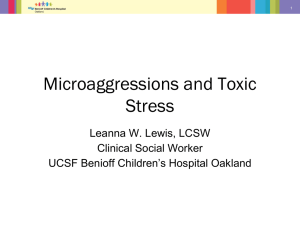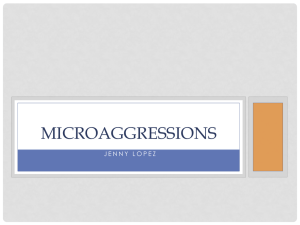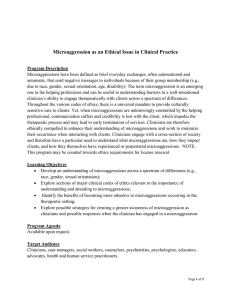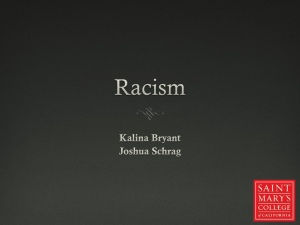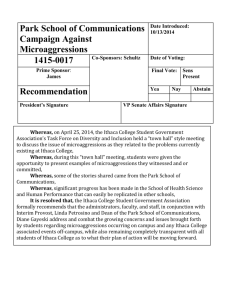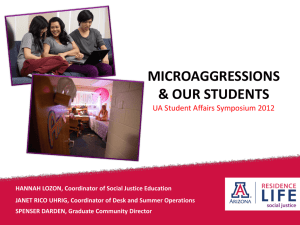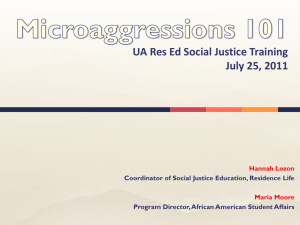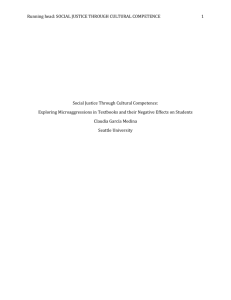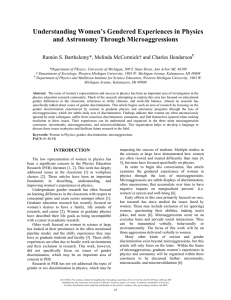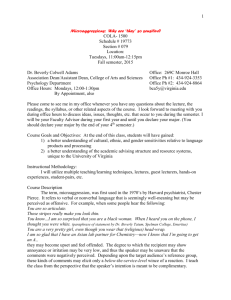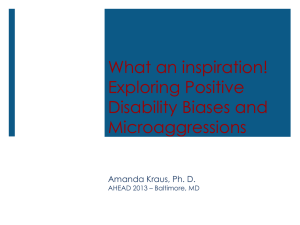Summary of Chapter 5
advertisement
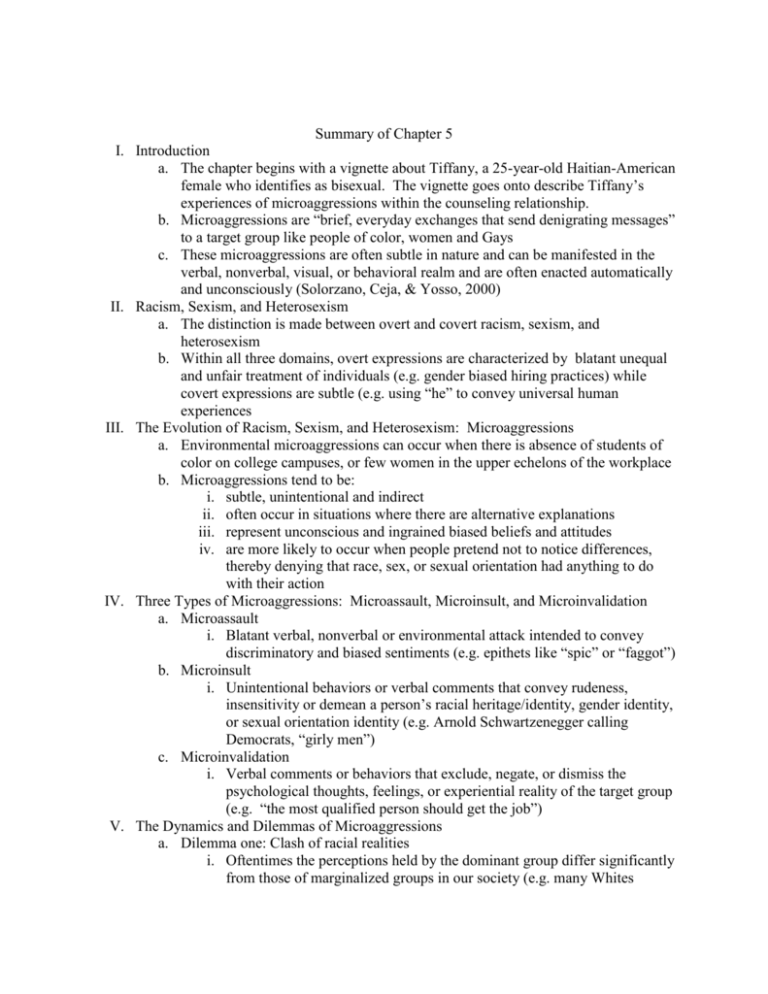
Summary of Chapter 5 I. Introduction a. The chapter begins with a vignette about Tiffany, a 25-year-old Haitian-American female who identifies as bisexual. The vignette goes onto describe Tiffany’s experiences of microaggressions within the counseling relationship. b. Microaggressions are “brief, everyday exchanges that send denigrating messages” to a target group like people of color, women and Gays c. These microaggressions are often subtle in nature and can be manifested in the verbal, nonverbal, visual, or behavioral realm and are often enacted automatically and unconsciously (Solorzano, Ceja, & Yosso, 2000) II. Racism, Sexism, and Heterosexism a. The distinction is made between overt and covert racism, sexism, and heterosexism b. Within all three domains, overt expressions are characterized by blatant unequal and unfair treatment of individuals (e.g. gender biased hiring practices) while covert expressions are subtle (e.g. using “he” to convey universal human experiences III. The Evolution of Racism, Sexism, and Heterosexism: Microaggressions a. Environmental microaggressions can occur when there is absence of students of color on college campuses, or few women in the upper echelons of the workplace b. Microaggressions tend to be: i. subtle, unintentional and indirect ii. often occur in situations where there are alternative explanations iii. represent unconscious and ingrained biased beliefs and attitudes iv. are more likely to occur when people pretend not to notice differences, thereby denying that race, sex, or sexual orientation had anything to do with their action IV. Three Types of Microaggressions: Microassault, Microinsult, and Microinvalidation a. Microassault i. Blatant verbal, nonverbal or environmental attack intended to convey discriminatory and biased sentiments (e.g. epithets like “spic” or “faggot”) b. Microinsult i. Unintentional behaviors or verbal comments that convey rudeness, insensitivity or demean a person’s racial heritage/identity, gender identity, or sexual orientation identity (e.g. Arnold Schwartzenegger calling Democrats, “girly men”) c. Microinvalidation i. Verbal comments or behaviors that exclude, negate, or dismiss the psychological thoughts, feelings, or experiential reality of the target group (e.g. “the most qualified person should get the job”) V. The Dynamics and Dilemmas of Microaggressions a. Dilemma one: Clash of racial realities i. Oftentimes the perceptions held by the dominant group differ significantly from those of marginalized groups in our society (e.g. many Whites believe that racism is no longer prevalent in society nor important in the lives of people of color ; heterosexuals believe that homophobia is a “thing of the past” and that antigay harassment is on the decline) b. Dilemma two: The invisibility of unintentional expressions of bias i. When the teachers commented on Tiffany’s hairstyle in the vignette, they might feel stunned and surprised to learn that Tiffany felt offended. To Tiffany, however, it was less about the content of what they said than the tone of voice (fear, apprehension and defiance of expectations) which indicated they were reacting to her race and gender. The message being conveyed to Tiffany was that she was violating White standards of appearance and that her braided hair, a natural Black hairstyle, was threatening c. Dilemma three: Perceived minimal harm of microaggressions i. Despite the perpetrator’s perception that microaggressions result in minimal harm, more recent research has suggested that subtle forms of racism, sexism, and heterosexism cause significant distress and negatively impact well being d. Dilemma four: The catch-22 of responding to microaggressions i. The fundamental issue is that “responding to a microaggression can have detrimental consequences for the victim.” ii. In the vignette, if Tiffany responds to the teachers they might attribute Tiffany’s reactions to some internal attribute (“being touchy or insecure”) and if she chooses to pursue the matter she can be accused of being a ‘troublemaker” reinforcing a commonly held stereotype of the “angry Black woman VI. Therapeutic Implications a. Clients of color tend to prematurely terminate counseling and therapy at a 50% rate after only the first initial contact with a mental health provider (ala Tiffany) and if gender and sexual orientation microaggressions operate through therapists, they may also affect the therapeutic alliance for these groups as well. b. Microaggressions may lie at the core of the problem c. In counseling and psychotherapy, the credibility of the therapist is paramount in determining whether clients stay or leave sessions d. Credibility is composed of two dimensions: expertness and trustworthiness. i. Expertness is a function of how much knowledge, training, experience, and skills clinicians possess with respect to the population being treated. It is an ability component. ii. Trustworthiness, however, is a motivational component that encompasses trust, honesty and genuineness. e. Effective counseling is likely to occur when both therapists and clients are able to form a working relationship, therapeutic alliance or some form of positive coalition VII. Manifestations of microaggressions in counseling/therapy a. Helping professionals to understand the worldviews of their culturally diverse clients in order to not minimize the racial realities of their clients b. Minimizing the impact of a microaggressions on your clients c. Locating the source of the problem within the client d. Validate and do not pathologize your client’s reactions to microaggressions VIII. Implications for Clinical Practice a. Be aware that racial, gender and sexual orientation microaggressions are a constant reality in the lives of culturally diverse groups b. Be aware that everyone has and continues to engage in unintentional microaggressions c. Do not invalidate the experiential reality of culturally diverse group d. Don’t get defensive if your culturally diverse client implies that you have engaged in a microaggressive remark or behavior
